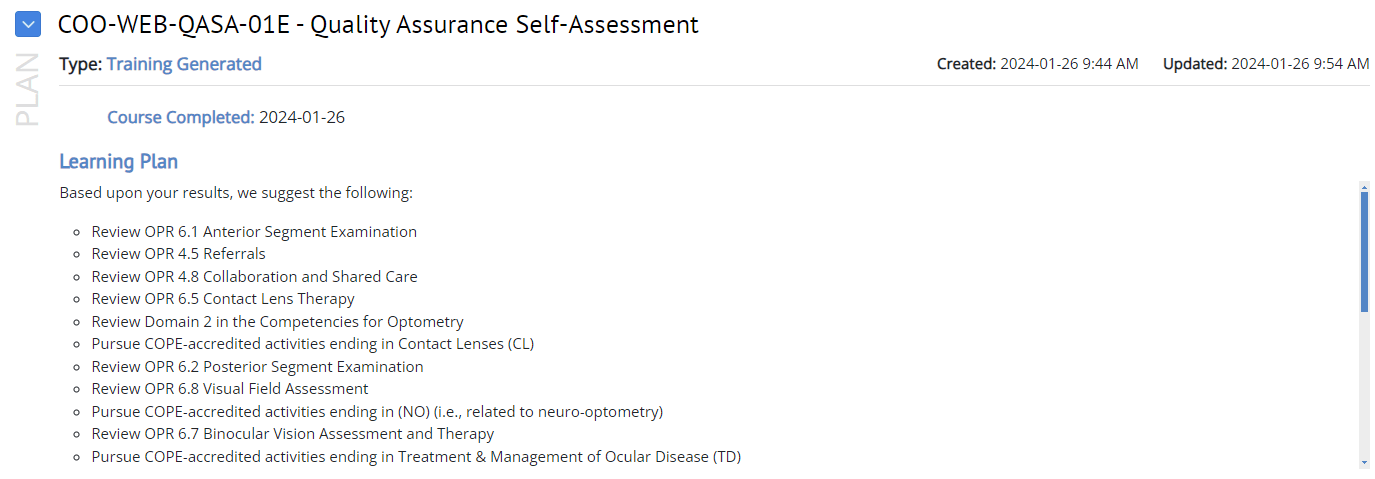Important: Part One must be completed in one sitting. You will only have one attempt to complete it.
The self-assessment is completed once per three-year CE cycle. The current CE cycle runs from January 1, 2024 until December 31, 2026.
As set out in the Regulated Health Professions Act (RHPA), 1991, Section 80.1, the Quality Assurance (QA) Program for all colleges shall include self, peer, and practice assessments. The QA Program shall also include a mechanism for the College to monitor optometrists’ participation in, and compliance with, the QA program.
In 2022, subject matter experts developed the self-assessment based on relevant, real-life situations in eyecare. They were drawn from key risks identified by College data.
In 2023, the College completed a pilot program of the self-assessment and received positive feedback. On September 15, 2023, Council approved the self-assessment component of the College’s QA program.
All optometrists, both practising and non-practising, are required to engage in the QA Program’s self-assessment component.* The objective of self-assessment is to assist optometrists to identify areas for improvement, develop concrete and structured goals, participate in meaningful CE activities, and self-reflect on the impact of the activities on their practice. These are powerful skills that help optometrists grow and engage in lifelong learning that is critical to providing quality care to patients.
*While completion of the QA Program self-assessment is mandatory, the results and feedback are solely for the registrant. The results will remain confidential and will not be used by the College for evaluation purposes.
The self-assessment is completed once per three-year CE cycle. The current CE cycle runs from January 1, 2024 until December 31, 2026. The requirements that must be met by optometrists in the current cycle are detailed in the College’s Self-Assessment Policy below:
Completing your self-assessment
The self-assessment is a two-part online exercise:
PART ONE – SCENARIOS AND MULTIPLE-CHOICE QUESTIONS
Part One of the self-assessment must be completed in one sitting. You have one attempt to complete it. Please set aside at least one (1) hour to complete it. You will review seven scenarios and answer related multiple-choice questions. There are five multiple-choice questions per scenario.
- Click here to log into your member portal. Use the same login credentials you use to complete your membership renewal.
- On the home page, click “eLearning Module”.
- On the eLearning home page, click “Quality Assurance Self-Assessment”
- Carefully read and follow the instructions on-screen to complete Part One.
At the conclusion of the self-assessment, you will receive feedback based on the questions you answered incorrectly. The feedback will help identify your learning opportunities and needs and provide resources to find information. This part is not scored (i.e., there is no pass or fail).
PART TWO – LEARNING PLAN
After completing Part One of the self-assessment, you will use the feedback and resources from Part One to create a Learning Plan. The Learning Plan encourages optometrists to set specific goals, select appropriate CE activities, and reflect on the impact of their learning.
- Click here to log into your member portal. Use the same login credentials you use to complete your membership renewal.
- On the home page, click “eLearning Module”.
- On the top right, click “Learning Plan”.
- You will see two types of learning plans:
a. The feedback from Part One is automatically generated in the Training Generated Learning Plan (Figure 1). This plan is locked and cannot be edited or deleted.

Figure 1. Example of a Training Generated Learning Plan
b. You are required to complete a User Generated Learning Plan (Figure 2) by following the steps below:
- On the top left, click “Add New Plan”.
- Fill in the “Plan Name”, “Learning Plan”, and “Learning Activities” sections. You do not have to complete the plan in one sitting. You can return anytime during the current three-year CE cycle to edit/add/delete your entries.
- To save your changes, click “Save” at the bottom right of the window. To cancel your changes, click “Close”.
- To edit your plan, click “Edit”. You can now also make entries to the “Reflection” section.

Figure 2. Example of a User Generated Learning Plan
COMPLIANCE AND SELF-ASSESSMENT AUDIT
The College will perform an audit at the conclusion of the current three-year cycle. The audit identifies those who fail to complete the self-assessment (both Part One and Part Two).
Optometrists who fail to complete the self-assessment may be referred to the Quality Assurance Committee and given an opportunity to complete a practice assessment at their own cost according to the College’s Schedule of Fees and Penalties. Optometrists who fail to complete the self-assessment and decline to complete the practice assessment may be referred to the Inquiries, Complaints and Reports Committee (ICRC) under Section 80.2 (1) of the RHPA for professional misconduct.
